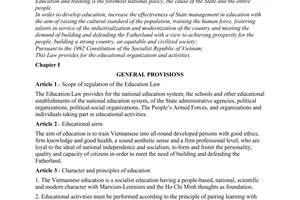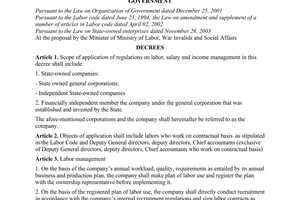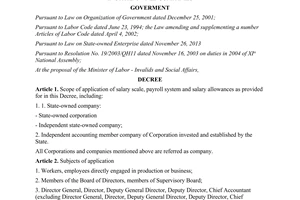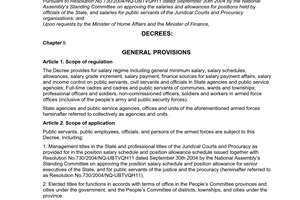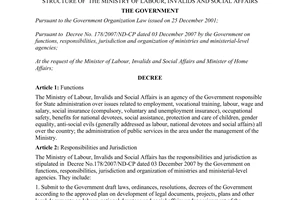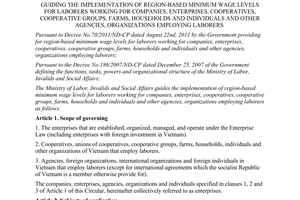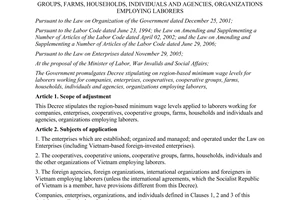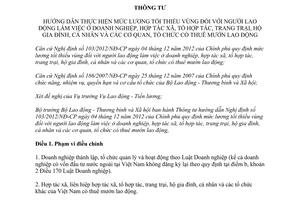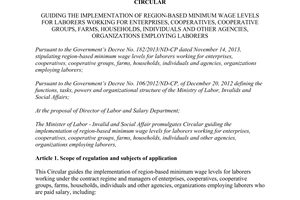Circular No. 29/2012/TT-BLDTBXH guiding the implementation of region-based minim đã được thay thế bởi Circular No. 33/2013/TT-BLDTBXH region-based minimum wage levels for laborers working và được áp dụng kể từ ngày 01/02/2014.
Nội dung toàn văn Circular No. 29/2012/TT-BLDTBXH guiding the implementation of region-based minim
|
THE MINISTRY
OF LABOUR, WAR INVALIDS AND SOCIAL AFFAIRS |
SOCIALIST
REPUBLIC OF VIETNAM |
|
No.: 29/2012/TT-BLDTBXH |
Hanoi, December 10, 2012 |
CIRCULAR
GUIDING THE IMPLEMENTATION OF REGION-BASED MINIMUM WAGE LEVELS FOR LABORERS WORKING FOR ENTERPRISES, COOPERATIVES, COOPERATIVE GROUPS, FARMS, HOUSEHOLDS, INDIVIDUALS AND OTHER AGENCIES, ORGANIZATIONS EMPLOYING LABORERS
Pursuant to the Government’s Decree No.103/2012/ND-CP of December 04, 2012, stipulating on region-based minimum wage levels for laborers working for enterprises, cooperatives, cooperative groups, farms, households, individuals and agencies, organizations employing laborers;
Pursuant to the Government’s Decree No.186/2007/ND-CP of December 25, 2007 defining the functions, tasks, powers and organizational structure of the Ministry of Labor, War Invalids and Social Affairs;
At the proposal of the Director General of Labor – Wage;
The Minister of Labor, War Invalids and Social Affairs promulgates Circular guiding the Government’s Decree No.103/2012/ND-CP of December 04, 2012, stipulating on region-based minimum wage levels for laborers working for enterprises, cooperatives, cooperative groups, farms, households, individuals and agencies, organizations employing laborers;
Article 1. Scope of regulation
1. Enterprises that are established, organized, managed, and operate under the Enterprise Law (including enterprises with foreign investment in Vietnam that not implement procedures for re-registration as prescribed in point b, clause 2 Article 170 of the Enterprise Law).
2. Cooperatives, unions of cooperatives, cooperative groups, farms, households, individuals and other organizations of Vietnam that employ laborers.
3. Agencies, foreign organizations, international organizations and foreign individuals in Vietnam that employ laborers (except for international agreements which the socialist Republic of Vietnam is a member otherwise provided for).
The companies, enterprises, agencies, organizations and individuals specified in clauses 1, 2 and 3 of this Article hereinafter collectively referred to as enterprises.
Article 2. Subjects of application
1. The laborers working under labor contracts as prescribed by the Labor Code.
2. Public employees as managers enjoying salaries in the enterprises, including: Management Board’s members, members of the Members Council or the company president, General Directors, Directors, Deputy General Directors, Deputy Directors, Accountant chiefs, inspectors and other persons working as managers.
Article 3. The region-based minimum wage level
1. Region-based minimum wage level applies to employees working for enterprises (hereinafter collectively referred to as region-based minimum wage level) as follows:
a) The level of 2,350,000 VND/month applies to the enterprises operating in the area of region I.
b) The level of 2,100,000 VND/month applies to the enterprises operating in the area of region II.
c) The level of 1,800,000 VND/month applies to the enterprises operating in the area of region III.
d) The level of 1,650,000 VND/month applies to the enterprises operating in the area of region IV.
2. The areas applying region-based minimum wage level are specified in the Appendix issued together with the Government’s Decree No.103/2012/ND-CP of December 04, 2012.
3. The areas applying region-based minimum wage level in some specific cases are defined as follows:
a) The area that has the change of name or split, temporarily comply with the region-based minimum wage level for the area before changing the name or splitting; in case of newly established areas from the areas with the various region-based minimum wage levels shall apply the region-based minimum wage level upon area with the highest region-based minimum wage level; in case of establishment of cities directly under provinces from an area or the areas of region IV, then implements the region-based minimum wage level applying to area of region III.
b) Enterprises operating in the adjacent areas with the various region-based minimum wage levels shall apply the region-based minimum wage level upon area with the highest region-based minimum wage level; enterprises having units, branches operating in the areas with the various region-based minimum wage levels, the unit or branch operating in a certain area, shall apply the region-based minimum wage level of such area.
c) The industrial zone, export processing zone located in the areas with various regional minimum wage levels, enterprises operating in such industrial zone, export processing zone apply the region-based minimum wage level upon area with the highest region-based minimum wage level; where industrial zones, export processing zones having sub-zones located on the areas with the various region-based minimum wage levels, enterprise operating in a sub-zone of certain area, shall apply the region-based minimum wage level of such area.
Article 4. Application of the region-based minimum wage level
1. The region-based minimum wage level prescribed by the Government is the lowest wage level as the basis for enterprises and employees to agree salaries to pay to the employees, but the wage level calculated by month paid to employees who are untrained, do the simplest jobs in the normal working conditions, ensure adequate standard working days in month and complete the labor norms or the works agreed upon, is not less than the region-based minimum wage level stipulated by the Government.
2. The lowest wage level required to pay to the employees who have undergone vocational training (including laborers who are trained by enterprises) must be at least 7% higher than the region-based minimum wage level stipulated by the Government.
The employees who have undergone vocational training include:
- Those who have been granted vocational certificates, vocational diploma, vocational secondary diploma in accordance with provisions of the Decree No.90/CP of November 24, 1993 defining the framework structure of the national education system, system of education and training diplomas and certificates;
- Those who have been granted vocational certificates, vocational diplomas under the provisions of the 1998 Education Law and the 2005 Education Law;
- Those who have been granted certificates under the regular vocational training programs, certificates of vocational primary, vocational secondary diploma, vocational college diploma or have completed vocational training program under the vocational training contract specified in the Law on Vocational Training;
- Those who have been granted vocational diplomas and certificates of foreign training institutions;
- Those who have been trained by enterprises or self-study and examined by enterprises, arranged to do the jobs required to be trained.
3. The region-based minimum wage level prescribed by the Government used as a basis for formulating and adjusting the wage levels of employees working in the enterprises elaborated and promulgated the wage scale, payroll according to provisions of the labor law as follows:
a) For the enterprises that have elaborated and promulgated the wage scales and payrolls shall be based on the region-based minimum wage level prescribed by the Government to review and adjust the wage level in the wage scales, payrolls, but must satisfy the principles of formulating the wage scales, payrolls in accordance to labor law; to determine and adjust the wage levels, allowances in labor contracts and perform other regimes for the employees properly.
b) For the enterprises that have not elaborated the wage scales and payrolls, shall be based on the region-based minimum wage level prescribed by the Government to calculate the wage levels when formulating wage scales and payrolls of the enterprises, but must satisfy the principles of formulating the wage scales, payrolls in accordance to labor law; to determine and adjust the wage levels, allowances in the labor contracts and perform other regimes for the laborers properly.
c) The adjustment of wage levels in the wage scales and payrolls, of determination of wage levels upon formulating the wage scales and payrolls, wage levels, allowances in labor contract and other regimes for the laborers as prescribed in point a and point b clause 3 this Article shall be agreed by the enterprise, the grassroots trade union executive committee and employees, but must ensure a reasonably-balanced wage relationship between laborers who are untrained and laborers who have been trained, and laborers with high professional qualifications and high technical skills, laborers who are recruited newly and laborers who have seniority of working in enterprises.
4. Upon applying the provisions of this Circular, the enterprises must not remove or cut the wage regimes when employees work overtime, work at night, wages or allowances to work in the hazardous, hard working conditions, regime of fostering in kind for the hard, hazardous careers and other regimes as prescribed by labor law.
Allowances, subsidies, and bonuses provided by enterprises shall comply with the agreements in labor contracts or collective labor agreements or in the Regulation of the enterprise.
5. To encourage enterprises in agreement to apply a minimum wage level that is higher than the region-based minimum wage level prescribed by the Government for use as a basis for implementation of the regulations specified in clause 3, Article 4 of this Circular; to pay salaries for employees at higher level compared with the provisions in clause 1 and clause 2, Article 4 of this Circular.
Article 5. Effectiveness
1. This Circular takes effect on January 25, 2013. The region-based minimum wage levels in Article 3 and regimes specified in this Circular are applied from January 01, 2013.
2. This Circular replaces the Circular No. 23/2011/TT-BLDTBXH of September 16, 2011 of the Ministry of Labor, War Invalids and Social Affairs, guiding implementation of region-based minimum wage levels for laborers working for companies, enterprises, cooperatives, cooperative groups, farms, households, individuals and agencies, organizations employing laborers.
3. For one member limited liability company owned by the State, state-owned companies that have not been transformed into limited liability companies or shareholding companies, organizations, units that are applying the wage regime as the previous state-owned companies or one member limited liability companies owned by the State (hereinafter collectively referred to as companies), upon determining the wage unit price of laborers and wage fund of public employees as managers in according to the Decree No. 206/2004/ND-CP of December 14, 2004; the Decree No.207/2004/ND-CP of December 14, 2004; the Decree No.86/2007/ND-CP of May 28, 2007; the Decree No.141/2007/ND-CP of September 05, 2007 of the Government, they shall select to apply the minimum wage levels as follows:
a) For companies ensuring to fully meet the conditions prescribed at the Circular No. 07/2005/TT-BLDTBXH the Circular No. 08/2005/TT-BLDTBXH dated January 05, 2005 and the Circular No.27/2010/TT-BLDTBXH of September 14, 2010 of the Ministry of Labor – War Invalids and Social Affairs are selected to apply the minimum wage level higher than the common minimum wage level prescribed by the Government by each period to determine the wage unit price of the employees and apply the coefficient of adjustment to raise additional wage fund in order to determine the planned wage fund of public employees as managers, but must ensure that the increase level (under rate %) of planned average wage compared with the implementation of the preceding year (from the wage fund approved by the owner) of public employees as specialized and responsible managers does not exceed the increase rate (under rate %) of planned average wages compared to the implementation of the preceding year of the employees.
b) For companies not ensuring to fully meet the conditions prescribed at the Circular No. 07/2005/TT-BLDTBXH the Circular No. 08/2005/TT-BLDTBXH dated January 05, 2005 and the Circular No. 27/2010/TT-BLDTBXH of September 14, 2010 of the Ministry of Labor – War Invalids and Social Affairs, not formulating or reporting wage price, or the plan of production, business losses or unprofitable, apply the common minimum wage level prescribed by the Government by each period to determine the wage unit price, regime wage fund of the employees and planned wage fund, wage fund of performance and regime wage fund of the public employees as managers.
When determining the wage fund of performance for laborers with regime wage level (being-enjoyed wage coefficient according to wage scale, payroll issued together with the Decree No.205/2004/ND-CP and the Decree No.204/2004/ND-CP of the Government multiply with the common minimum wage) lower than the region-based minimum wage shall be added the differential amounts between the regime wage level and the region-based minimum wage level to supplement in wage fund of performance and paid to the employees.
c) The management boards of construction investment projects of companies are selected to apply the minimum wage level higher than the common minimum wage level, but not exceeding the minimum wage level selected by the companies for calculation of wage unit prices and must ensure not to increase the administrative costs of the project management boards for use as a basis to establish wage fund to pay to the employees.
d) When the Labor Code, of June 18, 2012 takes effect, documents stipulated on the common minimum wage, wage scale, payroll are replaced by other documents, regulations on common minimum wage, wage scale, payroll in point a, b, c mentioned above shall comply with regulations of the replacing documents.
4. Funds for implementation of the region-based minimum wage as prescribed in this Circular shall be accounted into the price or cost of production and business of the enterprises.
5. The Ministers, Heads of ministerial-level agencies, Heads of Governmental agencies, the President of the People’s Committee of central-affiliated cities and provinces shall direct, urge and inspect the enterprises for implementation in accordance with provisions of this Circular.
In the course of implementation, any arising problems should be reported to the Ministry of Labor, War Invalids and Social Affairs for timely guidance and supplement.
|
|
FOR THE
MINISTER |
------------------------------------------------------------------------------------------------------
This translation is made by LawSoft,
for reference only. LawSoft
is protected by copyright under clause 2, article 14 of the Law on Intellectual Property. LawSoft
always welcome your comments

